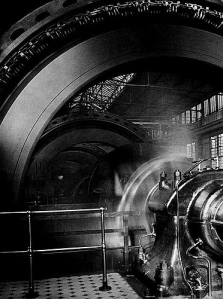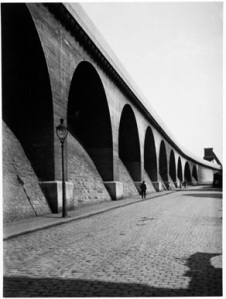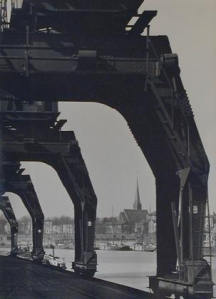Four Industrial Photographs by Albert Renger-Patzsch – A Review
By Claire Smallwood
Albert Renger-Patzsch was a successful and intriguing photographer from Germany, with a career spanning both decades and continents. But as I looked through a collection of his photographs, depicting everything from still life to flowers, four images, each focusing on the industrial era in a different way, remained on my mind and in my thoughts. They tell a tale in of themselves; a tale of a particular time, and a particular place, reflecting not just Renger-Patzsch’s leanings towards documentary photography, but also the period of time in which they were taken.
The first image is simply titled Industrial habor view, but it is clear, even from first glance, that the photograph contains much more than that.
[1]
Taken in the 1920’s, a time of great industrial and economic boom during which whole societies seemed to transform before peoples’ eyes, this photo somehow captures both the beauty and the ugliness of this great move into the ‘future’. Even from first glance this image is striking, if only for its contrast between the darkness of the harbour and the light that is breaking out through the grey cloud in the background, onto the city below it. The framing of this photograph, with the cloud surrounded by the dark scaffolding, is incredibly effective, drawing the eye to the distant city, as if the light was shining on it for that very reason. This image is much more remarkable in black and white than it would be in colour, simply because the darkness of the scaffolding, and the patterns created by it, are extenuated by the almost two tone nature of the photograph, as well as the sharp focus in which it was taken. It’s effectiveness as documentation is clear, simply because in one photograph, Renger-Patzsch has managed to combine both the harbour, with its industrialised structure, and the city, in all its traditional glory. Nothing is hidden, and the picture is all the more impressive for it.
The second of these photographs, another example of his interest in industry, is even clearer in highlighting Renger-Patzsch’s penchant for documentary photography.
[2]
The first thing that struck me about this image was the significant use of shapes – in particular, the concentric circles – in its composition. The steam rising from the machine adds to the image; it evokes the feeling of being in the presence of a powerful working machine, and is another effective example by Renger-Patzsch of good documentary photography. The use of a machine, a key part of the industrial developments of the time, as a subject in Renger-Patzsch’s photo collection is not surprising, given his interest in documenting industry, but what makes this image more significant is not the subject, but rather the way in which it is presented. The shiny engine in the foreground, highly focused, giving way to the vast structure behind it, gives the photograph a sense of real depth, highlighting the vast size of operations at this time, and perhaps reflecting the large scale at which things operated.
The third image, taken by Renger-Patzsch in 1928, again follows a similar pattern but in a completely different and unexpected way. Despite his obvious leanings towards documentary photography, there is a lot of artistic beauty contained in Renger-Patzsch’s work. It is as if he has found the beauty that already exists in the world, rather than searching for, or indeed creating it. Renger-Patzsch took the images as they were in real life, ugliness and beauty both.
[3]
The railway is an embodiment of industrialisation, but this is demonstrated unusually in this image. Instead of an image of a train in motion, or even the train tracks, the focus here is the railway embankment, a photograph taken from below, looking up, thereby excluding the tracks completely. This perspective is very effective, simply because it gives the impression of the size of the embankment, possibly a reflection of Industry in the 1920s as a whole. This is further exaggerated by the inclusion of the small man near the centre of the image. This figure, whose details are hidden by the distance and the shadows, highlights how small man is compared to some of the industrial endeavours of the time. Again, as in previous images, here Renger-Patzsch again uses dark, light and shadows to great effectiveness in this photograph. The shapes created by the arches of the railway are very striking, and the fact that they are getting smaller from left to right is effective in giving the photo a sense of depth and distance.
It is interesting that, in this photograph, the eye is draw to the crane sticking up in the sky in the distance. Our eyes are drawn there by the railway itself as it twists away from the camera, leading us to that point. It is not a pretty object, the crane, and yet perhaps that is why it is so effective. It represents the truth of the time; that machines were overtaking nature, progress usurping tradition. Renger-Patzsch documents this clearly in this photograph, and yet it is not something to be feared here, it is something to included, and more importantly, accepted.
[4]
Also taken in 1928, this final image is perhaps the most representative of the type of photographer Renger-Patzsch was.
Similar to the photograph of the ‘habor’, this image is striking for the juxtaposition of the new, bold and somewhat ugly structure in the foreground and the much more picturesque town/city in the background. The fact that the clearly industrial structure is in the foreground is incredibly significant because it frames the photograph, much in the way that industry itself framed society as a whole in this period. It is the combination of both these things that makes this image such a successful documentation of the time. To include both in one photograph is to emphasise that both are a part of society, and that neither can be ignored in favour of the other.
Looking at the four photographs together, the links between them are obvious; industry meets tradition, dark meets light. And yet, each image holds a uniqueness and individuality that highlight both Renger-Patzsch passion for documentary photography, and his clear talents in the area. Renger-Patzsch, as a protagonist in the ‘New Objectivity’ movement [5], was a stern believer in avoiding the Romanticisation of an image, and this clearly shows through in his work. When looking at these photographs, it is almost as if one is transported to another time and another place, and yet not one that has been made any more beautiful than it is in reality. Indeed, his aim at ‘Objective’ photography seems to have been achieved here. Each photograph seems to sum up European society in the 1920’s and it is as if he has captured the very idea of change itself.
[1] Luminous Lint, http://www.luminous-lint.com/app/vexhibit/_PHOTOGRAPHER_Albert__Renger-Patzsch_01/6/1/14454221157701491767778/, accessed on 25/01/13
[2] Luminous Lint, http://www.luminous-lint.com/app/vexhibit/_PHOTOGRAPHER_Albert__Renger-Patzsch_01/6/3/579412412576319507568981982/, accessed on 25/01/13
[3] Luminous Lint, http://www.luminous-lint.com/app/vexhibit/_PHOTOGRAPHER_Albert__Renger-Patzsch_01/6/4/6314762873566320618/, accessed on 25/01/13
[4] Luminous Lint, http://www.luminous-lint.com/app/vexhibit/_PHOTOGRAPHER_Albert__Renger-Patzsch_01/6/5/96243045134496477150/, accessed on 25/01/13
[5] Janzon, Thomas, ‘Overview’, http://mitpress.mit.edu/books/albert-renger-patzsch, accessed on 25/01/13
Bibliography:
Renger-Patzsch, Albert, Photographer of Objectivity, (Massachusetts, 1998)




Leave a comment